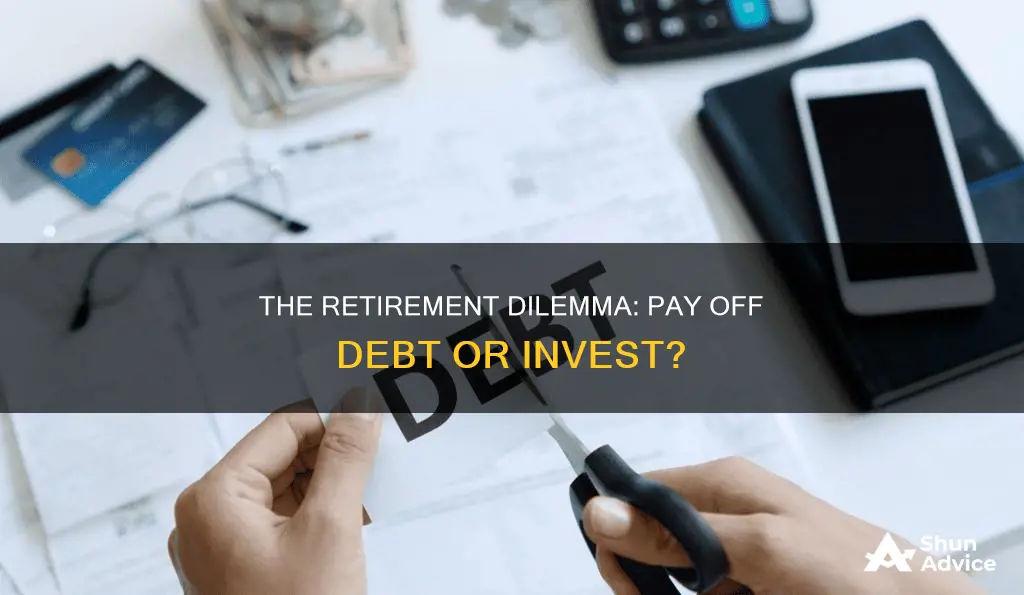
Whether to pay off debt or save for retirement is a highly personal decision that depends on an individual's financial situation and their emotional relationship with money. While some people advocate for paying off all debt before investing for retirement, others suggest investing in retirement while making minimum payments on low-interest debt.
A common guideline is to pay off debt with an interest rate of 6% or more before investing additional money towards retirement. This assumes that you already have emergency savings, have captured any employer match, and have paid off credit card debt.
However, this decision can be complex, and it is essential to consider various factors, such as tax implications, early withdrawal penalties, and the potential loss of future investment growth. Consulting a financial advisor can help individuals make informed decisions about their unique circumstances.
| Characteristics | Values |
|---|---|
| Interest rate on debt | If the interest rate on your debt is 6% or more, it is generally better to pay off debt before investing. |
| Type of debt | Credit card debt usually has high interest rates and can ruin your finances quickly. |
| Type of investment | If you have a 401(k) or IRA, you will likely incur penalties and taxes for early withdrawal. |
| Retirement age | If you are nearing retirement, paying off debt might be a priority. |
| Debt amount | If your total debt is reasonably small, it might be better to pay it off first. |
| Debt vs investment returns | If the interest on your debt is higher than the return on your investments, it is better to pay off the debt first. |
| Debt repayment plan | The snowball method suggests paying off the smallest debt first to quickly eliminate one bill. |
| Emergency fund | It is recommended to have 3-6 months of living expenses saved in an emergency fund. |
What You'll Learn

Evaluate your debts
Evaluating your debts is an important step in deciding whether to pay them off or invest for retirement. Here are some key considerations:
- List your debts: Make a comprehensive list of all your debts, including college loans, car payments, credit cards, and mortgages. Knowing the specifics of what you owe is crucial for making informed decisions.
- Assess interest rates: Identify the interest rates associated with each debt. Credit card balances, for instance, often incur high-interest rates, making them a priority for repayment.
- Minimum payments: Ensure you're meeting the minimum payment requirements for each debt. Failing to do so can lead to penalties and damage your credit score.
- Prioritize high-interest debt: Focus on clearing any debts with double-digit interest rates, such as credit card balances. These types of debt can be detrimental to your financial health and should be addressed urgently.
- Understand the impact of debt on your retirement savings: Consider how your debt affects your ability to save for retirement. High-interest debt can hinder your financial security and limit your investment options.
- Weigh the opportunity cost: Compare the interest rates on your debts with the potential returns on retirement investments. If the interest rate on your debt is higher than the expected return on investments, prioritising debt repayment may be more financially prudent.
- Seek professional advice: Consult a financial advisor or planner to help you navigate the complexities of debt repayment and retirement planning. They can provide personalised strategies based on your unique circumstances.
Cash Conundrum: The Great Homebuying Debate
You may want to see also

See if you have a 401(k) match
If you have a 401(k) plan, it's important to find out whether your employer offers matching contributions. This is when your employer adds a certain amount to your 401(k) account, in addition to what you contribute. Typically, employers match a percentage of employee contributions up to a specific portion of the total salary. For example, an employer might match 50% of your contributions, up to 6% of your annual salary. So, if you earn $60,000 per year and contribute $2,400 to your 401(k) (6% of your salary), your employer will add $1,200, bringing your total annual contributions to $3,600.
Some employers may match a higher percentage, or even offer a dollar-for-dollar match, up to a certain amount. For instance, an employer might match 100% of your contributions, up to 3% of your salary. So, if you earn $60,000 a year and contribute $1,800 (3% of your income), your employer will add an amount equal to 100% of your 401(k) contributions, raising your total annual contributions to $3,600.
Other employers may match up to a certain dollar amount, regardless of employee compensation. For example, an employer may match only the first $5,000 of your contributions.
It's important to note that not all employers offer matching contributions as part of their 401(k) plans. However, if they do, it's in your best interest to take advantage of this benefit. By maximising your employer's match, you're essentially getting free money that can significantly boost your retirement savings over the long term.
To find out if you have a 401(k) match and how it works, review the terms of your plan or check with your employer or HR representative.
Student Loans vs. Investing: Navigating the Debt-Investment Dilemma
You may want to see also

Build an emergency fund
Building an emergency fund is an essential part of a solid financial plan. It can help you pay unexpected expenses and avoid taking on more debt from high-interest credit cards or loans. It is also crucial for financial stability and peace of mind. Here are some steps to help you build an emergency fund:
- Make a budget: Understanding where and how you spend your money is essential to finding ways to save. Create a budget by calculating your income and expenses, and then set realistic savings goals. Even small amounts, such as $10 to $100 a month, can add up over time.
- Determine your emergency fund goal: The recommended amount for an emergency fund is three to six months' worth of living expenses. Calculate your monthly costs for essentials such as housing, food, transportation, and utilities, and then multiply that sum by six. If you have dependents or variable income, you may want to save up to eight months' worth of expenses.
- Set up direct deposits: Automate your savings by setting up direct deposits into your emergency fund. You can also use savings apps that automatically transfer a percentage of your paycheck into savings.
- Gradually increase your savings: Start small and gradually increase your contributions to your emergency fund over time. You can boost your savings rate by increasing the amount you contribute by a small percentage or a specific sum each month.
- Save unexpected income: If you receive a financial windfall, such as a tax refund or bonus, use at least a portion of it to boost your emergency fund.
- Keep saving after reaching your goal: Continue to save even after you have reached your initial savings goal. This will help you stay afloat for longer if you face a prolonged period of unemployment or illness.
By following these steps, you can build a solid emergency fund that will provide financial stability and peace of mind in the event of unexpected expenses or loss of income.
The Loan-Investment Dilemma: Navigating the Path to Financial Freedom
You may want to see also

Make a debt repayment plan
Making a debt repayment plan is a crucial step in achieving financial freedom. Here are the steps to create an effective debt repayment plan:
List Your Debts:
Start by creating a comprehensive list of all your debts, including the name of the lender, the total amount owed, the minimum monthly payment, interest rates, and any other relevant details. Contact your lenders to ensure you have the most up-to-date and accurate information.
Choose a Repayment Strategy:
There are several popular debt repayment strategies to choose from, including:
- The Avalanche Method: Focus on paying off the debt with the highest interest rate first while making minimum payments on other debts. Once the highest-interest debt is cleared, move on to the next highest-interest debt, and so on. This method saves you money on interest but may take longer to see results.
- The Snowball Method: This strategy involves paying off the smallest debt first while maintaining minimum payments on others. As each small debt is cleared, roll that payment into the next smallest debt. The snowball method provides quicker wins and can be motivating, but you may end up paying more in interest.
Prioritize Your Debts:
Decide on the order in which you want to tackle your debts. You can prioritize by balance amount, interest rate, or the type of debt (e.g., credit card debt, personal loan debt, etc.).
Find Ways to Increase Income:
If you're struggling to make more than the minimum payments, consider ways to bring in extra money. This could include working extra hours, taking on a side hustle or freelance work, selling personal items, or asking for a raise or bonus at your current job.
Focus on One Debt at a Time:
Regardless of the strategy you choose, focus on paying off one debt at a time. This approach will help you make faster progress and make it easier to track and manage your debts.
Cut Back on Expenses:
Look for ways to reduce your living expenses, such as negotiating lower rates on insurance or subscriptions, cancelling unused services, or cutting back on non-essential spending. This will free up more money to put toward debt repayment.
Make a Budget and Stick to It:
Create a realistic monthly budget that includes necessities, savings, debt payments, and other expenses. Ensure your budget aligns with your debt repayment goals, and try to avoid taking on any new debt during this time.
Stay Motivated:
Paying off debt can be a long and emotional journey. Find ways to stay motivated, such as joining support groups or celebrating small wins along the way. Visualize your life after becoming debt-free, and remember that you're working towards a financially secure future.
Consider Debt Consolidation or Refinancing:
If you have strong credit, you may be able to consolidate your debts with a low-interest loan or credit card. Alternatively, if you have high-interest debt and good credit, refinancing may help you secure a lower interest rate and smaller monthly payments.
Monitor Your Credit:
Keep track of your credit score and credit report during the debt repayment process. This will help you see the impact of your efforts and ensure that your payment history and balances are accurately reflected.
Remember, the key to a successful debt repayment plan is to be consistent and disciplined. It's important to find a strategy that works for your financial situation and temperament, and to make adjustments as needed to stay on track.
Canon Inc.: A Smart Investment Choice
You may want to see also

Maximise your retirement contributions
Maximising your retirement contributions is a great way to ensure a comfortable future. Here are some detailed strategies to help you maximise your retirement savings:
- Take responsibility for your retirement planning. The days of relying on pensions are long gone, and now it's up to you to ensure a comfortable retirement. Be proactive and take control of your retirement savings, investments and future income.
- Diversify your retirement plan. Spread your investments across different types of assets to reduce market risks. This strategy can also be applied to your retirement income. Combine various income sources, such as annuities, to protect yourself from unexpected risks.
- Create a lifetime income with growth potential. Annuities can provide a guaranteed income for life, and by including both fixed and variable annuities in your plan, you can achieve steady income with the potential for growth.
- Save enough to get the match. If your employer matches your contributions, ensure you save enough to take full advantage of this benefit. For example, if your employer matches your contributions up to 6% of your salary, contribute at least that amount to get the full benefit of their contribution.
- Consider contributing to a workplace retirement account. If your employer offers a 401(k) or 403(b) plan, find out their matching policy and contribute enough to get the maximum employer match. This is essentially free money, so don't leave it on the table!
- Maximise your health savings account (HSA). If you have an HSA-eligible health plan, contribute the maximum amount allowed. HSAs offer tax benefits and can be used for long-term health care savings or to pay for qualified medical expenses directly.
- Go beyond the employer match. If you've reached the maximum employer match, consider increasing your contributions further. Aim for the maximum allowed contribution, or at least 15% of your pre-tax salary, including your employer's contributions.
- Explore other retirement savings options. In addition to your workplace plan, consider contributing to an individual retirement account (IRA). There are several types of IRAs, each with its own benefits and requirements, allowing you to choose the one that best suits your needs.
- Add after-tax money to your 401(k). If your employer allows, you can contribute beyond the pre-tax limit by adding after-tax money to your 401(k). This gives you even more flexibility in saving for retirement.
- Invest in brokerage accounts. Once you've maximised your contributions to tax-advantaged retirement accounts, consider investing in regular brokerage accounts. While the tax advantages may not be the same, you'll still have the potential for long-term growth and flexible access to your money.
Remember, it's important to seek professional financial advice to ensure that your retirement planning aligns with your personal circumstances and goals.
Local Superfund Sites: Worthy Investment Opportunities
You may want to see also
Frequently asked questions
This depends on your financial situation and your emotional relationship with money. If you have high-interest debt, such as credit card debt, it is generally advisable to pay this off first. However, if you have low-interest debt and expect higher returns on your retirement investments, it may be a good idea to contribute to your retirement fund while gradually paying off your debt.
Paying off high-interest debt first can save you money in the long run. It can also help improve your credit score and relieve financial stress.
If you have low-interest debt and your retirement investments are expected to generate higher returns, contributing to your retirement fund while gradually paying off your debt can be a good strategy. Additionally, if your employer matches your contributions to your retirement fund, you should try to contribute enough to receive this benefit.







